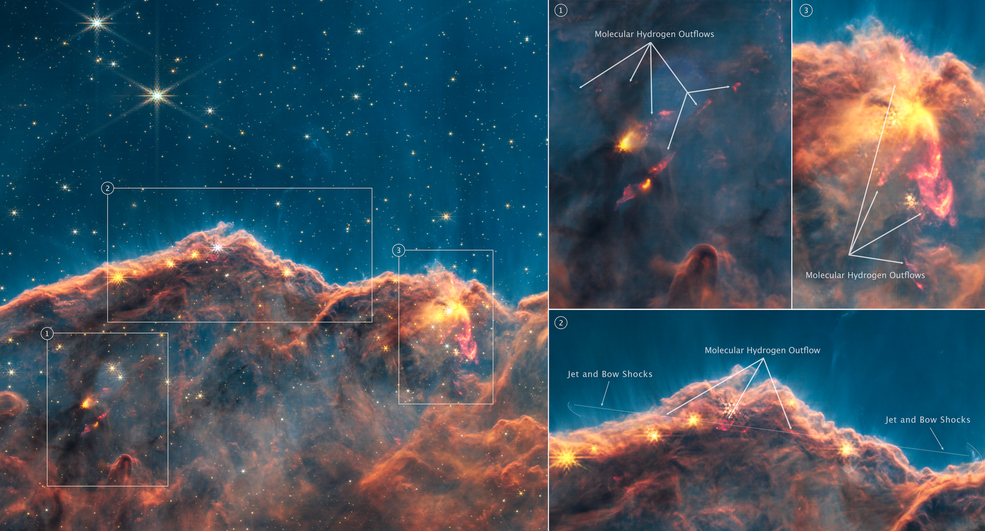 In 2022, Science Magazine awarded their Science Breakthrough of the Year to the NASA JW Space Telescope. In the time since, we have been mesmerized by the many new picture of our vast cosmos. Since ancient humans gazed up into the stars, we have always wondered what was out there in the universe, and we can find our fascination with the final frontier in our mythology, both from ages past and in contemporary science fiction. As humanity looks to return to the moon and establish further presence on Mars and beyond, let's take a look at our search for extraterrestrial life, if it is out there...or should I say, it's most likely out there!
In 2022, Science Magazine awarded their Science Breakthrough of the Year to the NASA JW Space Telescope. In the time since, we have been mesmerized by the many new picture of our vast cosmos. Since ancient humans gazed up into the stars, we have always wondered what was out there in the universe, and we can find our fascination with the final frontier in our mythology, both from ages past and in contemporary science fiction. As humanity looks to return to the moon and establish further presence on Mars and beyond, let's take a look at our search for extraterrestrial life, if it is out there...or should I say, it's most likely out there!
Is Anyone Out There?
 As they say, absence of proof is not proof of absence, but it is noticeable that we simply have not seen physical proof of life outside of our planet. As school kids we learned about the search for exoplanets in the habitable zones of stars similar to our own sun, the hunt for liquid water (hey, it's on Mars too!), and the detection of radio or other signals from galaxies far, far away. The current hellscape of Venus is a cautionary tale for our own greenhouse effect here on Earth, and there is disappointment that in spite of the evidence of water on Mars, it is devoid of life as we know it, even if H.G. Wells and Orson Welles (no relation) used their talents and imaginations to spin a fantastic tale.
As they say, absence of proof is not proof of absence, but it is noticeable that we simply have not seen physical proof of life outside of our planet. As school kids we learned about the search for exoplanets in the habitable zones of stars similar to our own sun, the hunt for liquid water (hey, it's on Mars too!), and the detection of radio or other signals from galaxies far, far away. The current hellscape of Venus is a cautionary tale for our own greenhouse effect here on Earth, and there is disappointment that in spite of the evidence of water on Mars, it is devoid of life as we know it, even if H.G. Wells and Orson Welles (no relation) used their talents and imaginations to spin a fantastic tale.
The Drake Equation is one of the most famous uses of math and probability to suggest the possibility of life outside our planet and solar system. Introduced by astronomer Frank Drake, this equation tries to estimate the number of civilizations in our Milky Way Galaxy that can transmit a detectable signal based on specific factors, including the rate of star formation and the number of planets around those stars that could support life. The first meeting of SETI (Search for Extraterrestrial Intelligence) revolved around this equation, and while nobody knows the actual "solution" to this particular math problem, we can be confident that the answer is greater than zero (not including our present civilization on Earth, of course). It is this confidence that continues to drive our imagination for science fiction involving alien life such as Star Trek, and in turn, inspiration for new generations of scientists to locate an interstellar neighbor that we can one day have a beer (or whatever it is they drink) with.
How Did Life Form?
Ever since the developing Earth cooled down enough to allow microorganisms to form, life on this planet has evolved and diversified into many different forms. While all aliens on Star Trek are nearly all conveniently humanoid (I guess it's easier to put some plaster on an actor's face than to make a six-legged insect model thing?), we know that, just like on Earth, life can take many forms.
 One of the big questions is what catalyzed the formation of life. An early exploration into the origins of life was the famous Miller-Urey Experiment, which bombarded a flask full of "building blocks" like water and methane with simulated lightning to produce some amino acids. Other experiments prescribe to the panspermia hypothesis, which suggests that the building blocks of life are present throughout the universe (we are all star stuff!) and can travel through space from one planet to another. Further support for panspermia has grown in recent years with the discovery of carbon and water in an asteroid returned from an ambitious space mission, which in turn corroborates findings of organic materials from meteorites that have landed on Earth. This is in addition to the hardiness of the legendary tardigrade, which can survive even the vacuum of space. Although we may never know exactly how life developed on Earth, the evidence science has gathered at least shows us what is possible.
One of the big questions is what catalyzed the formation of life. An early exploration into the origins of life was the famous Miller-Urey Experiment, which bombarded a flask full of "building blocks" like water and methane with simulated lightning to produce some amino acids. Other experiments prescribe to the panspermia hypothesis, which suggests that the building blocks of life are present throughout the universe (we are all star stuff!) and can travel through space from one planet to another. Further support for panspermia has grown in recent years with the discovery of carbon and water in an asteroid returned from an ambitious space mission, which in turn corroborates findings of organic materials from meteorites that have landed on Earth. This is in addition to the hardiness of the legendary tardigrade, which can survive even the vacuum of space. Although we may never know exactly how life developed on Earth, the evidence science has gathered at least shows us what is possible.
Astrobiology and Exobiology
 I feel like these terms are used interchangeably, and apparently exobiology is a subset of astrobiology, but the goal of both is to explore the extremes of life on Earth and from there, determine the possibility of habitability outside of our known biosphere. These disciplines are growing and are dedicated to understanding the origins and evolution of life on Earth so those principles can then be applied to searching for "alien" life. This involves the continued exploration and eventual human colonization of the moon and Mars, the deep space trips to the moons of Jupiter and Saturn, and the decades-long use of radio signals and space probes to tell any life out there that we are here.
I feel like these terms are used interchangeably, and apparently exobiology is a subset of astrobiology, but the goal of both is to explore the extremes of life on Earth and from there, determine the possibility of habitability outside of our known biosphere. These disciplines are growing and are dedicated to understanding the origins and evolution of life on Earth so those principles can then be applied to searching for "alien" life. This involves the continued exploration and eventual human colonization of the moon and Mars, the deep space trips to the moons of Jupiter and Saturn, and the decades-long use of radio signals and space probes to tell any life out there that we are here.
There are various lines of astrobiology research being explored now by NASA and others. As with the Miller-Urey experiment, there is a lot of interest in how life happened in the first place, as well as how the building blocks of life got to their planets of origin. Between the JWST images and data, the continuing discoveries of exoplanets, and the rover explorations on Mars, astrobiology has opened up a literal universe of possibilities that we will find that new (hopefully) friend out there in the cosmos.
Life As We (Might Not) Know It
Though it makes sense (now) for humans to be standing upright and have opposable thumbs and a big brain and all that good stuff that makes us the dominant species on this planet, that doesn't mean extraterrestrial life, when we finally encounter it, will be familiar-looking or even humanoid. This is the basis behind xenobiology, which suggests that life could be borne from chemistry that is foreign to what drives life on Earth, and potentially even be synthetically created. We already know how weird life can get on this planet, so it is entirely possible life from another world could look even more strange, and not even employ the same chemistry of metabolism that terrestrial biology is accustomed to.
 The study of xenobiology may seem like mad science, but it opens up yet another avenue of possibility that life could evolve on exoplanets that are not in their stars' habitable zones, or use a different primary solvent than water, and might not even be based on DNA or standard genetic principles. Thinking completely outside the box, outside of what we already know, can further enlighten our understanding of life and the fundamental principles of what can be possible to generate life. As a fun side benefit, xenobiology also has industrial applications, incorporating non-biological or unusual molecules such as selenocysteine into chemical reactions and manufacturing.
The study of xenobiology may seem like mad science, but it opens up yet another avenue of possibility that life could evolve on exoplanets that are not in their stars' habitable zones, or use a different primary solvent than water, and might not even be based on DNA or standard genetic principles. Thinking completely outside the box, outside of what we already know, can further enlighten our understanding of life and the fundamental principles of what can be possible to generate life. As a fun side benefit, xenobiology also has industrial applications, incorporating non-biological or unusual molecules such as selenocysteine into chemical reactions and manufacturing.
Maybe We'll Just Come to You
Since extraterrestrial life isn't banging on our door just yet, the alternative strategy is to go out there and find them ourselves. This is the inspiration behind space travel and our continued human presence in orbit on board the International Space Station. Because nothing can physically surpass the speed of light, and since the nearest star system to us is about four light-years away, any trip to visit a potential neighbor will take years, possibly centuries, at the minimum, which means humans may have to consider not just how to pack in all the supplies and recycle breathable air for a trip of that length, but also may have to reproduce and train the next generation of explorers to continue the journey.
A mountain of knowledge from decades of human space exploration has given us insights into the effects of microgravity on biology. One recent publication in October 2023 showed that mouse embryos grown on the Space Station appeared to be normal, although they did not seem to allow the embryo to develop into a pup. There are other studies of microgravity on pregnant mice that suggested it would be possible to have healthy offspring despite the effects of space travel, but we are a long way from paying some astronauts very handsomely to consummate in space and see what happens with the resulting space love child (I'm now curious as to whether an infant can survive the G-forces of re-entry). Although that might be another obstacle, as in a study that may one day join the ranks of the greatest Ig Nobel achievements, it appears that space flight might have a link to erectile dysfunction. I'm sure NASA and Viagra are hard at work on that now!
A Universe of Possibility
Once NASA and friends can push aside enough red tape, we will see humanity head back to the stars through moon and Mars missions and beyond. While we await the next round of technological and medical advancements to propel astronauts farther than any human has ever traveled while protecting their bodies, we can rest assured that human ingenuity has not reached its limit yet and more discoveries are yet to come. Maybe someday, astronomers can finally decipher one of those signals they received from civilizations that might have long passed on, while another signal may come back to say, "Hey, we got your message, and we're on our way to say hello."




